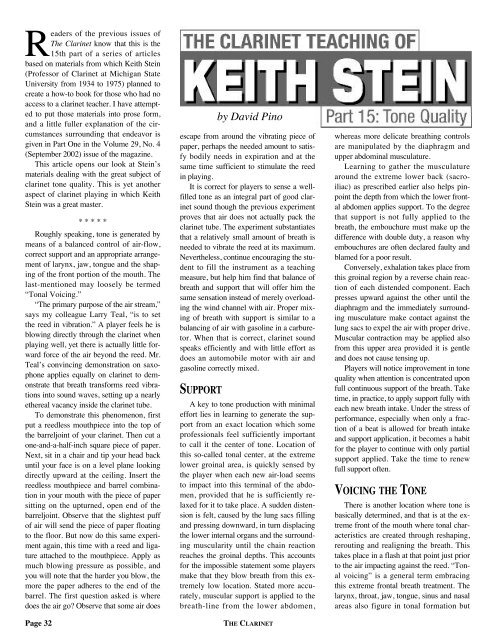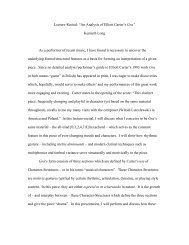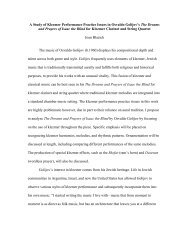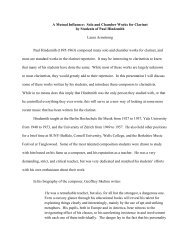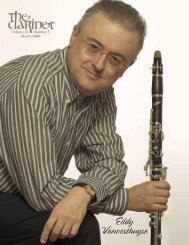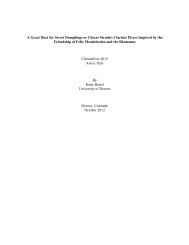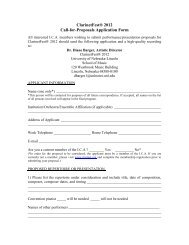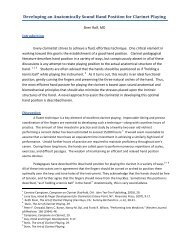Volume 33 Number 3 June 2006 - International Clarinet Association
Volume 33 Number 3 June 2006 - International Clarinet Association
Volume 33 Number 3 June 2006 - International Clarinet Association
- No tags were found...
You also want an ePaper? Increase the reach of your titles
YUMPU automatically turns print PDFs into web optimized ePapers that Google loves.
Readers of the previous issues of<br />
The <strong>Clarinet</strong> know that this is the<br />
15th part of a series of articles<br />
based on materials from which Keith Stein<br />
(Professor of <strong>Clarinet</strong> at Michigan State<br />
Uni versity from 1934 to 1975) planned to<br />
create a how-to book for those who had no<br />
access to a clarinet teacher. I have attempted<br />
to put those materials into prose form,<br />
and a little fuller explanation of the circumstances<br />
surrounding that endeavor is<br />
given in Part One in the <strong>Volume</strong> 29, No. 4<br />
(September 2002) issue of the magazine.<br />
This article opens our look at Stein’s<br />
materials dealing with the great subject of<br />
clarinet tone quality. This is yet another<br />
aspect of clarinet playing in which Keith<br />
Stein was a great master.<br />
* * * * *<br />
Roughly speaking, tone is generated by<br />
means of a balanced control of air-flow,<br />
correct support and an appropriate ar rangement<br />
of larynx, jaw, tongue and the shaping<br />
of the front portion of the mouth. The<br />
last-mentioned may loosely be termed<br />
“Ton al Voicing.”<br />
“The primary purpose of the air stream,”<br />
says my colleague Larry Teal, “is to set<br />
the reed in vibration.” A player feels he is<br />
blowing directly through the clarinet when<br />
playing well, yet there is actually little forward<br />
force of the air beyond the reed. Mr.<br />
Teal’s convincing demonstration on saxophone<br />
applies equally on clarinet to dem -<br />
onstrate that breath transforms reed vibrations<br />
into sound waves, setting up a nearly<br />
ethereal vacancy inside the clarinet tube.<br />
To demonstrate this phenomenon, first<br />
put a reedless mouthpiece into the top of<br />
the barreljoint of your clarinet. Then cut a<br />
one-and-a-half-inch square piece of paper.<br />
Next, sit in a chair and tip your head back<br />
until your face is on a level plane looking<br />
directly upward at the ceiling. Insert the<br />
reedless mouthpiece and barrel combination<br />
in your mouth with the piece of paper<br />
sitting on the upturned, open end of the<br />
barreljoint. Observe that the slightest puff<br />
of air will send the piece of paper floating<br />
to the floor. But now do this same experiment<br />
again, this time with a reed and ligature<br />
attached to the mouthpiece. Apply as<br />
much blowing pressure as possible, and<br />
you will note that the harder you blow, the<br />
more the paper adheres to the end of the<br />
barrel. The first question asked is where<br />
does the air go Observe that some air does<br />
Page 32<br />
escape from around the vibrating piece of<br />
paper, perhaps the needed amount to satisfy<br />
bodily needs in expiration and at the<br />
same time sufficient to stimulate the reed<br />
in playing.<br />
It is correct for players to sense a wellfilled<br />
tone as an integral part of good clarinet<br />
sound though the previous experiment<br />
proves that air does not actually pack the<br />
clarinet tube. The experiment substantiates<br />
that a relatively small amount of breath is<br />
needed to vibrate the reed at its maximum.<br />
Nevertheless, continue encouraging the stu -<br />
dent to fill the instrument as a teaching<br />
measure, but help him find that balance of<br />
breath and support that will offer him the<br />
same sensation instead of merely overloading<br />
the wind channel with air. Proper mixing<br />
of breath with support is similar to a<br />
balancing of air with gasoline in a carburetor.<br />
When that is correct, clarinet sound<br />
speaks efficiently and with little effort as<br />
does an automobile motor with air and<br />
gasoline correctly mixed.<br />
SUPPORT<br />
by David Pino<br />
A key to tone production with minimal<br />
effort lies in learning to generate the support<br />
from an exact location which some<br />
professionals feel sufficiently important<br />
to call it the center of tone. Location of<br />
this so-called tonal center, at the extreme<br />
lower groinal area, is quickly sensed by<br />
the player when each new air-load seems<br />
to impact into this terminal of the ab do -<br />
men, provided that he is sufficiently re -<br />
laxed for it to take place. A sudden distension<br />
is felt, caused by the lung sacs filling<br />
and pressing downward, in turn displacing<br />
the lower internal organs and the surround -<br />
ing muscularity until the chain reaction<br />
reaches the groinal depths. This accounts<br />
for the impossible statement some players<br />
make that they blow breath from this ex -<br />
tremely low location. Stated more accurately,<br />
muscular support is applied to the<br />
breath-line from the lower abdomen,<br />
THE CLARINET<br />
where as more delicate breathing controls<br />
are manipulated by the diaphragm and<br />
upper abdominal musculature.<br />
Learning to gather the musculature<br />
around the extreme lower back (sacroiliac)<br />
as prescribed earlier also helps pinpoint<br />
the depth from which the lower front -<br />
al abdomen applies support. To the degree<br />
that support is not fully applied to the<br />
breath, the embouchure must make up the<br />
difference with double duty, a reason why<br />
embouchures are often declared faulty and<br />
blamed for a poor result.<br />
Conversely, exhalation takes place from<br />
this groinal region by a reverse chain reaction<br />
of each distended component. Each<br />
presses upward against the other until the<br />
diaphragm and the immediately surrounding<br />
musculature make contact against the<br />
lung sacs to expel the air with proper drive.<br />
Muscular contraction may be applied also<br />
from this upper area provided it is gentle<br />
and does not cause tensing up.<br />
Players will notice improvement in tone<br />
quality when attention is concentrated upon<br />
full continuous support of the breath. Take<br />
time, in practice, to apply support fully with<br />
each new breath intake. Under the stress of<br />
performance, especially when only a fraction<br />
of a beat is allowed for breath intake<br />
and support application, it becomes a habit<br />
for the player to continue with only partial<br />
support applied. Take the time to renew<br />
full support often.<br />
VOICING THE TONE<br />
There is another location where tone is<br />
basically determined, and that is at the ex -<br />
treme front of the mouth where tonal characteristics<br />
are created through reshaping,<br />
rerouting and realigning the breath. This<br />
takes place in a flash at that point just prior<br />
to the air impacting against the reed. “Ton -<br />
al voicing” is a general term embracing<br />
this extreme frontal breath treatment. The<br />
larynx, throat, jaw, tongue, sinus and nasal<br />
areas also figure in tonal formation but


